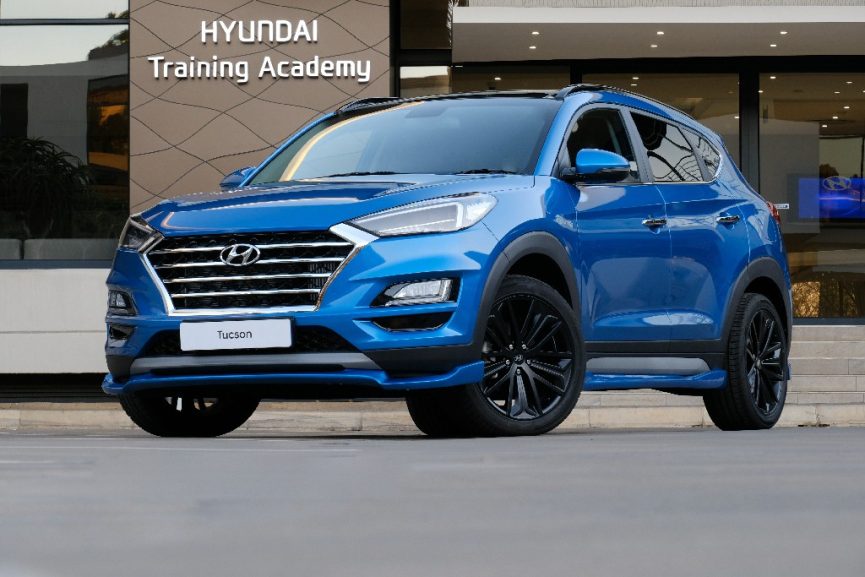Hyundai Tucson Sport!!!
Hyundai’s Tucson range in South Africa has been bolstered with a new derivative with bold looks, an engine power and torque boost, and a deeper exhaust sound to claim its territory as the sportier version of this top-selling SUV.
When Hyundai Automotive South Africa initially launched the Tucson Sport in 2017, it was an immediate hit, with an order book that was filled quickly at the dealers. In the meantime, the Tucson has undergone a design facelift in 2018 – on its exterior looks as well as the interior.
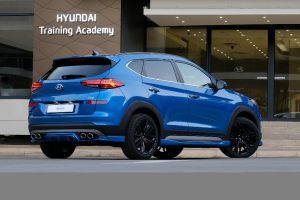
“After the midlife upgrade of the Tucson, the time was ripe to create another Sport derivative, with mainly the same treatment as before, but with the attractive looks that came with the upgrade to the Tucson,” says Stanley Anderson, sales & operations director at Hyundai Automotive South Africa.
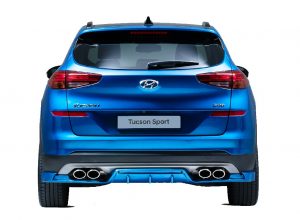 “We have again fitted the Tucson with bespoke black rims and a body kit that gives it a very sporty look without being overbearing. Tucson customers have really taken to the Sport after our first ‘experiment’, so we could confidently repeat the exercise this time,” says Anderson.
“We have again fitted the Tucson with bespoke black rims and a body kit that gives it a very sporty look without being overbearing. Tucson customers have really taken to the Sport after our first ‘experiment’, so we could confidently repeat the exercise this time,” says Anderson.
The Sport is available in two derivatives: The petrol version with a 1,6-litre turbocharged engine, and a diesel version with a 2-litre turbocharged engine.
The 1.6-litre petrol turbo delivers 150 kW at 5 500 r/min. and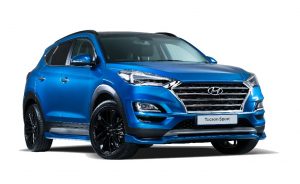 maximum torque of 300 Nm at 4 500 r/min. Power is fed to the front wheels through an automatic 7-speed Dual Clutch Transmission (DCT), with the option of manual shift override.
maximum torque of 300 Nm at 4 500 r/min. Power is fed to the front wheels through an automatic 7-speed Dual Clutch Transmission (DCT), with the option of manual shift override.
The 2-litre turbodiesel also delivers 150 kW, but at lower engine revolutions of 4 000 r/min. Torque delivery from the turbodiesel is an impressive 460 Nm in an engine speed range of 1 750 to 2 750 r/min. This engine, also delivering power to the front wheels, is coupled with an 8-speed automatic transmission which also offers a manual shift option.

The Tucson Sport’s interior is similar to the other derivatives in the range, sporting a dashboard with a floating 7-inch screen for its infotainment system that offers features such as linkage to Apple’s CarPlay or the Android Auto application on smartphones.
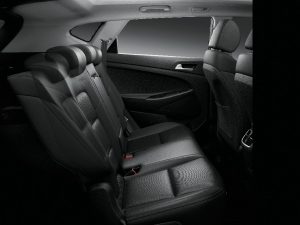 In the case of the Sport derivative, the top specification level was chosen, including features such as electric seat adjustment for the driver and passenger, dual climate control, rear air vents, rear parking assist cameras and a rear-view camera with a display on the infotainment screen, and a panoramic sunroof.
In the case of the Sport derivative, the top specification level was chosen, including features such as electric seat adjustment for the driver and passenger, dual climate control, rear air vents, rear parking assist cameras and a rear-view camera with a display on the infotainment screen, and a panoramic sunroof.
The Tucson’s upper dashboard features high-quality soft-touch material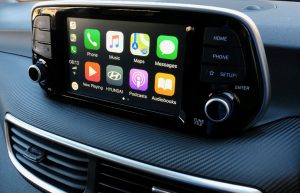 with a double stitching line for a high-quality feeling in the interior. The focal point of the centre console is the floating audio system screen, which has an ergonomic position to allow drivers to stay focused on the road. The infotainment system in the Tucson offers a satellite navigation function when used with one’s Apple cell phone and CarPlay, or the Android Auto application.
with a double stitching line for a high-quality feeling in the interior. The focal point of the centre console is the floating audio system screen, which has an ergonomic position to allow drivers to stay focused on the road. The infotainment system in the Tucson offers a satellite navigation function when used with one’s Apple cell phone and CarPlay, or the Android Auto application.
 With the addition of the Sport, the Tucson range in South Africa now consists of nine derivatives with a choice between three engines – a naturally aspirated 2-litre petrol engine; the turbocharged 1,6-litre petrol engine and the 2-litre turbocharged diesel – and three specification levels. All derivatives are front-wheel driven.
With the addition of the Sport, the Tucson range in South Africa now consists of nine derivatives with a choice between three engines – a naturally aspirated 2-litre petrol engine; the turbocharged 1,6-litre petrol engine and the 2-litre turbocharged diesel – and three specification levels. All derivatives are front-wheel driven.
Premium, for the entry-level derivatives, including cruise control, an infotainment system with a 7-inch touch screen, LED daytime running lights and driver, passenger, side and curtain airbags. The 4-cylinder, 2-litre naturally aspirated petrol engine, delivering 115 kW and 196 Nm maximum torque, is used for the Premium derivatives, in combination with either a 6-speed manual or 6-speed automatic gearbox.
Executive, with, inter alia, added standard features such as an Electronic Stability Programme (ESP) and Vehicle Stability Management (VSM), leather seats, Blind Spot Detection for side mirrors, Cross Traffic Alert detectors at the rear, electric seat adjustment for the driver and a full auto air conditioner with climate control. An Executive derivative with the 2-litre petrol engine, delivering power through a 6-speed auto gearbox, is a new addition to the range, as well as the Tucson R2.0 Executive with a 131 kW, 400 Nm 2-litre turbodiesel engine and new 8-speed automatic gearbox.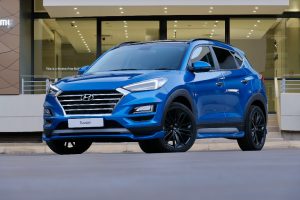
Elite, with top-of-the-range added standard features such as a panoramic sun roof, electric seat adjustment for the front passenger as well, a push-button to start the engine and keyless entry. The Elite derivatives also include the Blind Spot Detection and Cross Traffic Alert safety features. Another standard feature is the extra USB port in the rear, delivering additional power to recharge the devices on-board if needed.
Elite Sport, with the same features as the Elite derivative, as well as the bespoke rims, side skirts, front and rear spoilers and dual exhausts.
Safety
Apart from the Blind Spot Detection and Cross Traffic Alert (in the Executive, Elite and Sport versions), the Tucson is equipped with passive safety features such as dual front and side airbags (driver and front passenger) and curtain airbags that offer protection for rear passengers as well in all derivatives. Isofix latching points for child safety seats are also fitted to all Tucson derivatives.

Executive, Elite and Sport derivatives of the Tucson are also equipped with Vehicle Stability Management that keeps the car stable on wet, slippery or rough roads, as well as Hill-start Assist Control to prevent roll-back when pulling off against an incline.
Pricing
The prices of the Tucson Sport are:
| Tucson 1.6 TGDI Sport (Dual Clutch Transmission) | R654 900 |
| Tucson R2.0 Sport Turbodiesel (automatic) | R664 900 |
All prices include:
- A 5 year/90 000 km service plan;
- A 7-year/200 000 km warranty; and
- Roadside assistance for 7 years or 150 000.
All service intervals are 15 000 km, with a mandatory initial 5 000 km service for the Tucson 1.6 TGDI Elite and Sport derivatives.



